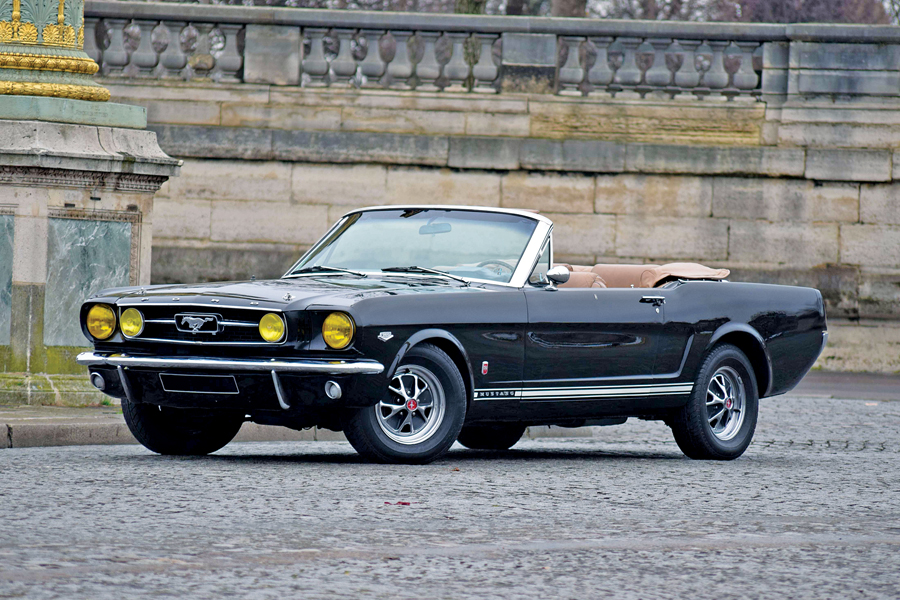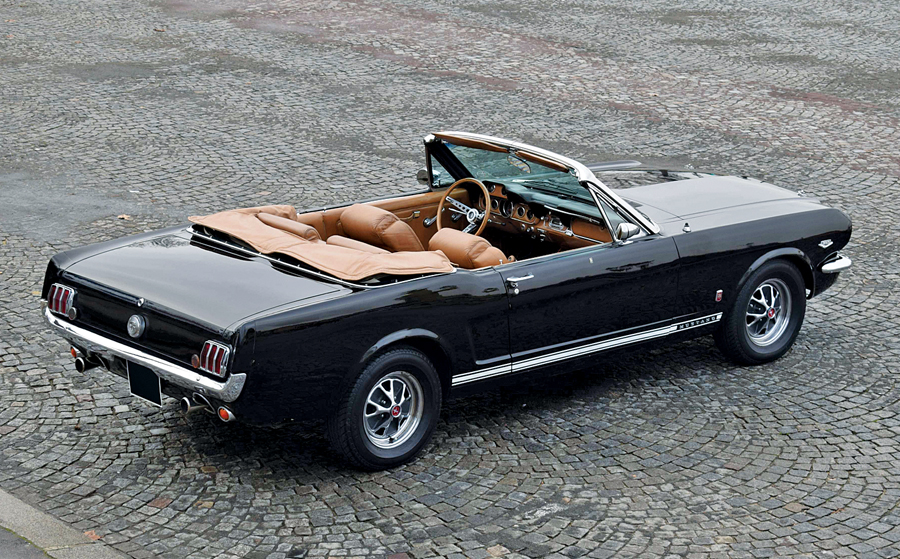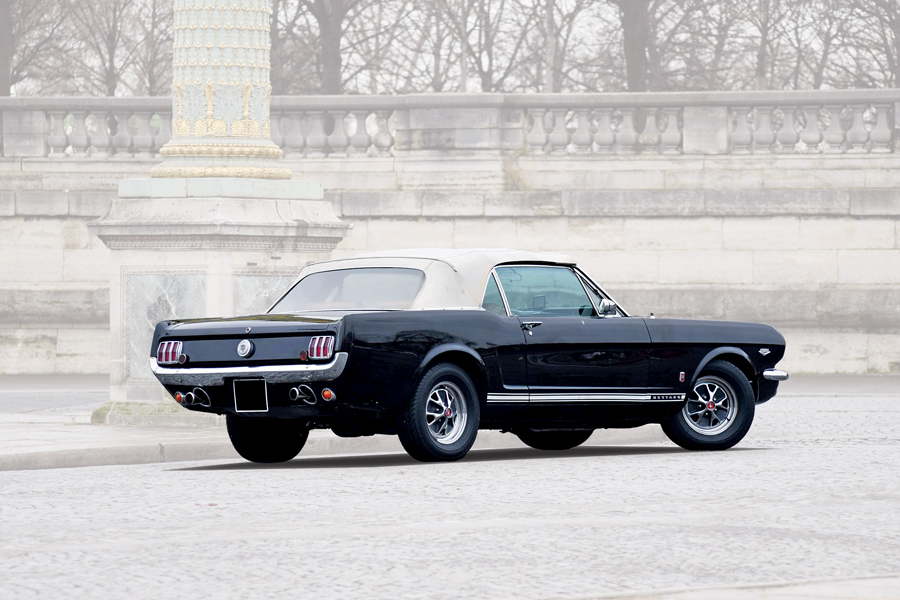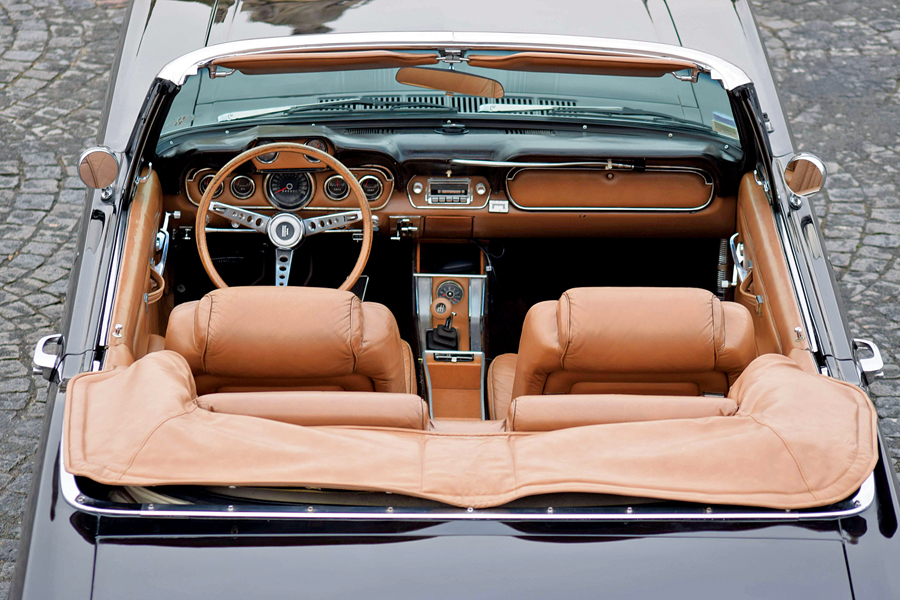SCM Analysis
Detailing
| Vehicle: | 1966 Ford Mustang GT Convertible |
| Years Produced: | 1965–66 |
| Number Produced: | 13,231 (all body styles) |
| Original List Price: | $3,825 |
| SCM Valuation: | $42,000 |
| Tune Up Cost: | $300 |
| Chassis Number Location: | Driver’s side fender apron |
| Engine Number Location: | Front of the block on the passenger’s side — above the oil pan |
| Club Info: | Mustang Club of America |
| Website: | http://www.mustang.org |
| Alternatives: | 1968 Shelby GT350 convertible, 1967 Shelby GT350, 1968 Shelby GT500 KR |
| Investment Grade: | B |
This car, Lot 124, sold for $226,756, including buyer’s premium, at Artcurial’s auction in Paris, France, on February 9, 2018.
In the world of collectible cars, we see all sorts of machines, and they range from investment grade to casual drivers. There are very special cars with wonderful histories, and there are those with all sorts of warts — and questionable, dubious stories.
This is, at least on the surface, one of those cars with a wonderful and very interesting history to tell. Let’s dive in.
As an auction analyst for Sports Car Market — and its sister publication, American Car Collector — I am perpetually swimming in cars with questionable provenance, unsubstantiated stories, mystery paperwork and so on.
What a car really is, in many cases, is not what it is reported to be. I hope I’ve awakened some curiosity. We all need to be curious when a car’s history has more to do with its value than the actual car itself.
“You better win”
All eyes were on Ford at the 1966 24 Hours of Le Mans, as Henry Ford II, aka “Hank the Deuce,” was launching an all-out assault on Ferrari.
Team Ford — with the bottomless Dearborn coffers, the ingenuity of Carroll Shelby and the direction of Leo Beebe — engineered and assembled a group of eight weapons-grade projectiles known as the Ford GT40 (plus five additional independent Fords) for the 1966 24 Hours of Le Mans.
It was win or nothing — beat Ferrari at all costs. The race was on.
As the story goes, Beebe was given one very simple directive: Put a Ford in the winner’s circle. Leo even kept a card from Henry Ford II. It said: “You better win.”
The rest is history. The Ford GT40 not only won at Le Mans — it dominated, taking 1st, 2nd and 3rd place.
For the first time in history, an American car won Le Mans. It’s a magnificent story that optimizes the vigor of the American spirit and the unflappable determination of a few good men — along with a very deep supply of cash.
Henry II’s K-code Mustang GT convertible
Our subject car was presented as a Ford Mustang GT convertible custom built specifically for Henry Ford II.
A certificate from Ford France, dated January 3, 1991, confirms it was Ford’s car. Even better, Mr. Robert Chatet, a Ford subcontractor, discovered the car in France during 1967.
Somehow, the astute Mr. Chatet managed to get the Ford Motor Company to give him the car. As the story goes, the car had been parked at Ford France’s head office at Rueil-Malmaison with 15,000 km (9,320 miles) on the clock, and had simply been sitting there ever since. Chassis 285715 remained in the hands of Mr. Chatet, and it eventually was passed on to his son, who consigned the car to the Artcurial Paris sale.
Driven at Le Mans — maybe
Are we ready to be curious yet?
While I’m not disputing the catalog text from Artcurial, there was one key sentence to notice: “Could be the course-opening vehicle for 1966 24 Hours of Le Mans.”
Well, is it or isn’t it?
As it turns out, and as confirmed by email communication with Mr. Antoine Mahé, the Artcurial car specialist for the Mustang — Artcurial was also cautious about that portion of the history.
According to the Artcurial research, which was quite thorough, there is a photo that does, indeed, show Henry Ford II in the back seat of a Mustang convertible at Le Mans. That’s very good, but it’s not airtight.
Why not?
The deflating leak here is that the Mustang in that historic photograph is red, not black. And there was no evidence that red paint was evident, even in minute traces, on our subject black car. That’s not so good.
Stay tuned.
In the grand scheme of things, Mr. Ford’s ownership is very special — and it’s a great story. I’m sort of fussy about these things, so I want proof that I can hang my hat on.
Driving history
No matter what the hazy Le Mans facts may show, this is indeed a historic car. It has a lot of custom touches that one might expect on a 1966 Mustang that was built specifically for Henry Ford II.
Of course, the fact that the Mustang is black (Hank the Deuce loved black cars — as did his grandfather), and adorned with HFII badges and a custom interior, makes it even more special.
Adding to that, it’s a 1966 K-code Mustang GT 4-speed convertible in France. That’s a valuable car even without the HFII provenance.
Whether or not our subject Mustang was a course-opening car for Le Mans doesn’t factor into the value equation all that much. It was a historic moment for Ford — and the United States, for that matter. It’s safe to say that Hank the Deuce drove the car and used it at Le Mans — and that’s pretty cool.
Digging a little deeper
I did some diligent research on this car. As I poked around, it was amazing to see how one thing can lead to another. Calls are made and returned — and new information is discovered.
Based on two reliable sources with personal knowledge of the car, our subject car was actually a custom Mustang — and considered a prototype design. The interior was reported as a Ford Design Center styling cue for the 1968 Mercury Cougar — down to the door panels. You’ll immediately see the similarities. One source said he held notes and paperwork on the car from one of the Ford designers who actually participated in the design.
I also spoke with two very kind gentlemen who own custom HFII Mustangs, and the like-kind similarities between their cars and our subject car were very interesting indeed. It was also reported to me that the car did not participate at Le Mans, but may have been on the grounds — so there was some discussion on that subject.
Valuing history
Chassis 285715 is not only a part of Ford history — it symbolizes the American fighting spirit. When you mess with us (insert Ferrari backing out of a deal to sell his company to Ford) — we have a tendency to bite back. The junkyard dog in this case was a muscular car with Ford V8 power called the GT40. In 1966, the Ford GT40 showed Ferrari her taillights, not once, but three times in a row. That’s priceless.
The overall condition of the Mustang was a tad weathered and unwinding a bit. As shown in the photos at the Artcurial website, Henry’s old Mustang was showing 66,953 km (41,602 miles) on the clock. The car has obviously been driven, and it shows. That’s okay. You don’t build a custom 289 HiPo 4-speed Mustang GT to park it.
Was this car well bought or well sold?
The value in this car is the story and the history. All in, she sold for $266,756. There have been plenty of very special Mustangs that have sold for far more. The record is a very rare 1967 Shelby Super Snake that rang the bell loud and clear at a Mecum sale for $1.3 million in 2013. A few others have sold for numbers north of $500,000. Given that, $266,756 doesn’t sound too bad.
Whether our subject Mustang was the course-opening car at the 1966 24 Hours of Le Mans or not, it’s still a one-of-a-kind Mustang with ties to Ford’s huge 1966 sweep at Le Mans — and Hank the Deuce himself.
Hats off to Mr. Chatet for discovering the car — and to his son for taking great care of it. I suspect that ol’ Hank the Deuce would be pleased. Fairly bought — but with plenty of room to run. ♦
(Introductory description courtesy of Artcurial.)



